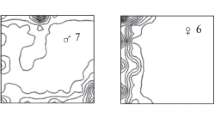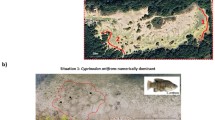Abstract
Interactions of overwintered females with conspecifics (≥5 days) on familiar territories were studied experimentally. In interactions of the resident females with unfamiliar overwintered females (28 experiments), there were no differences related to the reproductive status of both parties. Between the behavior of the residents and aliens, there were no significant differences, except the refusals of contacts—and aliens had more of it. Identification and affiliative behavior and the presence of ritualized aggression was noted. There was little direct aggression. Females were sharply aggressive toward the overwintered males (23 experiments) regardless of their reproductive status. Males tried to avoid contacts. Identification and affiliative behavior were rare. Toward yearlings (25 experiments), females that participated in reproduction were aggressive (direct aggression prevailed) but singles (9 experiments) were not.
Similar content being viewed by others
References
Barnard, C.J. and Brown, C.A.J., The Effects of Prior Residence, Competitive Ability and Food Availability on the Outcome of Interactions between Shrew (Sorex araneus L.), Behav. Ecol. Sociobiol., 1982, vol. 10, no. 4, pp. 307–312.
Blumstein, D.T., The Evolution of Infanticide in Rodents, in Infanticide by Males and Its Implications, Schaik, C.P. and Janson, C.H., Eds., Cambridge: Camb. Univ. Press, 2000, pp. 178–197.
Borries, C., Launhardt, K., Epplen, C., et al., DNA Analyses Support the Hypothesis That Infanticide Is Adaptive in Langur Monkeys, Proc. Biol. Sci., 1999, vol. 266, no. 1422, pp. 901–904.
Bunn, D.S., Fighting and Moult in Shrews: Fighting and the Defense of Territory, J. Zool., 1966, vol. 148, no. 4, pp. 580–582.
Bystrakova, N.V., Shchipanov, N.A., Bulatova, N.Sh., et al., New Data on the Geographic Distribution of Chromosome Races of Sorex araneus (Soricidae, Eulipotyphla) in European Russia, Rus. J. Theriol., 2007, vol. 6, no. 1, pp. 105–109.
Churchfield, S., The Natural History of Shrews, London: Christopher Helm, 1990.
Ebensperger, L.A., Strategies and Counterstrategies to Infanticide in Mammals, Biol. Rev. Camb. Philosoph. Soc., 1998, vol. 73, no. 3, pp. 321–346.
Grinnell, J. and McComb, K., Maternal Grouping as a Defense against Infanticide by Males: Evidence from Field Playback Experiments on African Lions, Behav. Ecol., 1996, vol. 7, no. 1, pp. 55–59.
Hrdy, S.B., Infanticide as a Primate Reproductive Strategy, Am. Sci., 1977, vol. 65, no. 1, pp. 40–49.
Hrdy, S.B., Infanticide Among Animals: A Review, Classification, and Examination of the Implications for the Reproductive Strategies of Females, Ethol. Sociobiol., 1979, vol. 1, no. 1, pp. 13–40.
Ivanter, E.V. and Makarov, A.M., Study of the Territorial Structure of Populations of Small Insectivorous Mammals, in Biologiya, ekologiya, biotekhnologiya i pochvovedenie (Biology, Ecology, Biotechnology, and Soil Science), Moscow: Izd. Mosk. Gos. Univ., 1994, pp. 106–123.
Ivanter, E.V. and Makarov, A.M., Territorial’naya ekologiya zemleroek-burozubok (Insectivora, Sorex) (Territorial Ecology of Shrews (Insectivora, Sorex)), Petrozavodsk: Izd. Petrozav. Univ., 2001.
Khodashova, K.S. and Eliseeva, V.I., Zemleroiki v ekosistemakh Tsentral’noi lesostepi Russkoi ravniny (Eliseev Shrews in Ecosystems of the Central Forest-Steppe of the Russian Plain), Moscow: Nauka, 1992.
Luchnikova, E.M., Ethological Factors of Community Organization of Shrews (Insectivora, Soricidae), Extended Abstract of Cand. Sci. (Biol.) Dissertation, Novosibirsk: IsiEZh SO RAN, 2004.
Luchnikova, E.M., Il’yashenko, V.B., and Teplova, N.S., Age-Related Aspects of the Behavior of the Common Shrew (Sorex araneus L., 1758), Estestv. Tekhnich. Nauki, 2010, no. 2, pp. 150–153.
Michielsen, C.N., Intraspecific and Interspecific Competition in the Shrews Sorex araneus L. and Sorex minutus L., Arch. Neerl. Zool., 1966, vol. 17, no. 1, pp. 73–174.
Moraleva, N.V., Intraspecific Interactions in the Common Shrew Sorex araneus in Central Siberia, Ann. Zool. Fennici, 1989, no. 26, pp. 425–432.
Moraleva, N.V. and Sheftel’, B.I., Territorial Behavior of the Common Shrew in Puberty, in I Vsesoyuznoe soveshchanie po biologii nasekomoyadnykh mlekopitayushchikh. Novosibirsk, 4–7 fevralya 1992 g. (I All-Union Conference on the Biology of Insect-Eating Mammals. Novosibirsk, February 4–7, 1992), Moscow, 1992, pp. 120–121.
Moraleva, N.V., patial-Ethological Structure of a Population of the Common Shrew (Sorex araneus L.), Extended Abstract of Cand. Sci. (Biol.) Dissertation, Moscow: IEMEZh AN SSSR, 1992.
Oleinichenko, V.Yu., Kalinin, A.A., Demidova, T.B., and Kuptsov, A.V., The Use of Space by Overwintered Female Common Shrews (Insectivora, Soricidae) according to Life Trap Data, Zool. Zh., 2006, vol. 85, no. 4, pp. 533–543.
Oleinichenko, V.Yu., Behavioral Relationships of Overwintered Common Shrews (Sorex araneus) with Conspecific Shrews, in Teriofauna Rossii i sopredel’nykh territorii (VIII s”ezd Teriologich. o-va): Mater. mezhdunar. soveshch (Theriofauna of Russia and Adjacent Countries (Proc. VII Int. Congr. Theriol. Soc.), Moscow: KMK, 2007a, p. 351.
Oleinichenko, V.Yu., Behavior of Juvenile Common (Sorex araneus), Laxmann’s (S. caecutiens), and Pigmy (S. minutus) on Colonized and Foreign Territory, Zool. Zh., 2007b, vol. 86, no. 10, pp. 1–12.
Oleinichenko, V.Yu., Kalinin, A.A., Demidova, T.B., and Kuptsov, A.V., The Use of Space by Overwintered Male Common Shrews (Insectivora, Soricidae) according to Life Trap Data, Zool. Zh., 2007, vol. 86, no. 3, pp. 1–9.
Oleinichenko, V.Yu., Analysis of the Types of Spatial Distribution of Animals according to Tagging Data on Transects (As Exemplified by Common Shrews), Biol. Bull., 2008, no. 6, pp. 757–764.
Oleinichenko, V.Yu., Spatioethological Organization of Populations of the Common Shrew (Sorex araneus), in Povedenie i povedencheskaya ekologiya mlekopitayushchikh: Mater. 2-i nauchn. konf. Chernogolovka, 9–12 noyabrya 2009 g. (Proc. 2nd Sci. Conf. “Behavior and Behavioral Ecology of Mammals,” Chernogolovka, November 9–12, 2009), Moscow: KMK, 2009, p. 28.
Oleinichenko, V.Yu., Demidova, T.B., Kalinin, A.A., and Shchipanov, N.A., Notes on the Reproductive Behavior of the Common Shrew (Sorex araneus) in Captivity, Zool. Zh., 2011, vol. 90, no. 2, pp. 1–7.
Oleinichenko, V.Yu., Relationships between Adult Females and Settles Juveniles of the Common Shrew: The Competition for Space and Defense of Litters?, in Teriofauna Rossii i sopredel’nykh territorii: Mater. mezhdunar. soveshch (Proc. Int. Conf. “Theriofauna of Russia and Adjacent Areas”), Moscow: KMK, 2011, p. 344.
Rychlik, L., Evolution of Social Systems in Shrews, in Evolution of Shrews, Wojcik, J.M. and Wolsan, M., Eds., Bialowieza: Mammal Res. Inst., Polish Acad. Sci., 1998, pp. 347–406.
Searle, J.B., Breeding the Common Shrew (Sorex araneus) in Captivity, Lab. Anim., 1984, vol. 18, no. 4, pp. 359–363.
Shchipanov, N.A., Kalinin, A.A., Oleinichenko, V.Yu., and Demidova, T.B., General Characteristic of the Behavior of Shrews (Sorex araneus, S. caecutiens, S. minutus, and S. isodon (Insectivora, Soricidae), Zool. Zh., 1998, vol. 77, no. 4, pp. 444–458.
Shchipanov, N.A., Kalinin, A.A., Oleinichenko, V.Yu., et al., A Method to Study the Use of Space by Shrew, Zool. Zh., 2000, vol. 79, no. 3, pp. 362–371.
Shchipanov, N.A., Kalinin, A.A., Demidova, T.B., et al., Population Ecology of Red-Toothed Shrews, Sorex araneus, S. caecutiens, S. minutus, and S. isodon, in Central Russia, in Advances in the Biology of Shrews II: Special Publ. of the I Int. Soc. Shrew Biol. (ISSB), 2005, no. 1, pp. 201–215.
Shchipanov, N.A., Bulatova, N.Sh., Pavlova, S.V., and Shchipanov, A.N., Common Shrew (Sorex araneus)-A Model Species for Ecological and Evolutionary Studies, Zool. Zh., 2009, vol. 88, no. 8, pp. 975–989.
Stockley, P. and Searle, J.B., Shrew Mating Systems, in Evolution of Shrews, Wojcik, J.M. and Wolsan, M., Eds., Bialowieza: Mammal Res. Inst., Polish Acad. Sci., 1998, pp. 407–424.
Stockley, P., Searle, J.B., Macdonald, D.W., and Jones, C.S., Female Multiple Mating Behaviour in the Common Shrew as a Strategy to Reduce Inbreeding, Proc. Royal Soc. Lond. B, 1993, vol. 254, pp. 173–179.
Author information
Authors and Affiliations
Corresponding author
Additional information
Original Russian Text © V.Yu. Oleinichenko, 2012, published in Izvestiya Akademii Nauk, Seriya Biologicheskaya, 2012, No. 4, pp. 420–429.
Rights and permissions
About this article
Cite this article
Oleinichenko, V.Y. Behavioral interactions of adult females of the common shrew (Sorex araneus) with conspecifics on familiar territory. Biol Bull Russ Acad Sci 39, 351–359 (2012). https://doi.org/10.1134/S1062359012040073
Received:
Published:
Issue Date:
DOI: https://doi.org/10.1134/S1062359012040073




